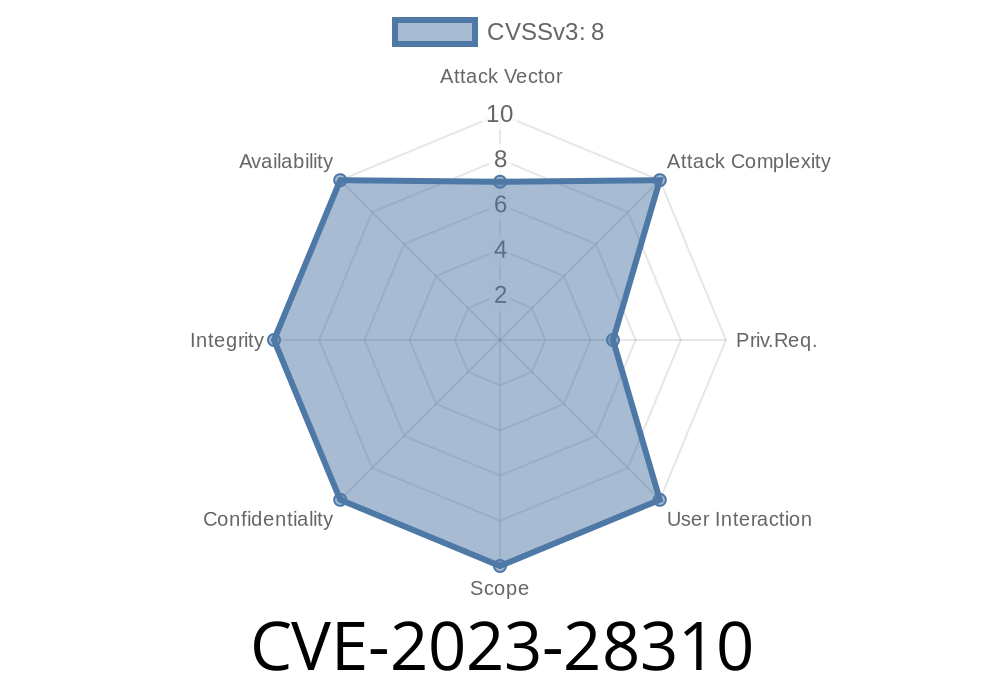Microsoft Exchange Server is a crucial player in many organizations, handling email and collaboration duties quietly in the background. But what happens when a serious vulnerability like CVE-2023-28310 pops up, exposing a pathway to remote code execution (RCE)? In this post, I’ll break down what CVE-2023-28310 is, how it works, show a simplified code snippet, and link you to the best original sources. If you manage Exchange, read closely — this is exclusive, actionable info to keep your networks safe.
What Is CVE-2023-28310?
CVE-2023-28310 is a Remote Code Execution vulnerability reported in Microsoft Exchange Server. Attackers exploiting this flaw can run their own code on the targeted server — a nightmare scenario that could lead to data theft, ransomware, or full server compromise.
Who Is at Risk?
If you run vulnerable versions of Microsoft Exchange accessible via the network, you’re at risk. This includes on-premises Exchange servers, especially those exposed to the internet. Even internal servers can be attacked by anyone who gains a foothold inside the network.
Vulnerability Details
CVE-2023-28310 resides in the way Exchange Server processes untrusted data as part of its web-based services (for example, OWA or ECP). An attacker tricks the server into deserializing a specially-crafted payload, exploiting a bug that lets them break out of normal controls and execute arbitrary code.
Microsoft’s official advisory is here:
Microsoft Security Guide: CVE-2023-28310
How Remote Code Execution is Possible
The heart of the problem is unsafe object deserialization. Put simply: when Exchange receives data from outside, it sometimes expects to get it in a particular format (like a user object or configuration). If this data isn’t properly checked, a clever attacker can sneak in something entirely different — like a command to launch a reverse shell.
Proof-of-Concept Code Snippet
Disclaimer: The following example is for educational purposes only. Never test on systems you do not control.
This C# snippet shows a simplified way unsafe deserialization might be exploited in .NET (used by Exchange):
using System;
using System.IO;
using System.Runtime.Serialization.Formatters.Binary;
public class Program
{
public static void Main()
{
// Malicious binary payload (e.g., serialized object with evil code)
byte[] maliciousPayload = File.ReadAllBytes("exploit_payload.bin");
// Vulnerable deserialization (DON'T DO THIS!)
BinaryFormatter formatter = new BinaryFormatter();
using (MemoryStream ms = new MemoryStream(maliciousPayload))
{
formatter.Deserialize(ms); // Attacker code runs here!
}
}
}
In a real Exchange exploit:
A similar unsafe deserialization would happen deep in the Exchange web service stack when it handles attacker-supplied user data.
Typical exploitation would involve
- Finding the vulnerable endpoint. For Exchange, this could be /ecp/ or /owa/ paths.
Building the payload. Attackers use tools like ysoserial.net to create malicious objects.
- Sending the payload. A POST request with the evil object embedded (often in JSON or XML) to the endpoint.
- Gaining code execution. Once deserialized, the attacker’s command is run by the server process, giving them control.
Exploit Tools:
- ysoserial.net
- SharpSerializePayload
Example (conceptual, not direct exploit)
curl -X POST https://victim.exchange.local/ecp/ -d "payload=<malicious blob>"
Mitigations and Patches
Microsoft issued patches in April 2023.
If you haven’t patched, do it ASAP
- Apply all security updates for your Exchange versions. (Patching guidance)
References & Further Reading
- Microsoft Advisory CVE-2023-28310
- Rapid7 Analysis
- Threatpost Explainer
- ysoserial.net Tool
Final Thoughts
CVE-2023-28310 is a scary reminder that even well-defended systems like Microsoft Exchange can harbor hidden dangers. The essence here is old-school: always patch fast, never trust user input, and stay alert for new RCE bugs. If you found this deep dive helpful, bookmark it — and keep your Exchange servers locked down!
Timeline
Published on: 06/14/2023 15:15:00 UTC
Last modified on: 06/14/2023 15:30:00 UTC
